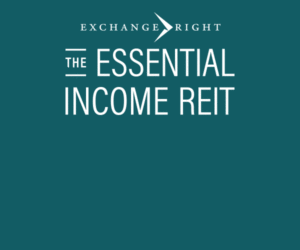Characteristics of Nontraded REITs
Intro
If you’re considering investing in a nontraded REIT your financial advisor has recommended to you, there are some key things to know about what makes these REITs different from others.
Nontraded REITs are:
- Not publicly traded
- Illiquid
- Sold at a fixed share price
- Known to demonstrate “low correlation” with other types of investments
- Subject to defined life cycles and events
- Not subject to corporate income taxes like other corporations. As long as a REIT distributes 90% of its income to its shareholders, that income is taxed only at the shareholder level and is not subject to the double taxation of corporate profits faced by the typical corporation.
We’ll delve further into each of these topics so that you can have a clearer understanding of why some investors choose to add nontraded REITs to their overall investment portfolio.
Not publicly traded
REITs generally fall into three categories – publicly traded, public nontraded, and private. A publicly traded REIT functions much like a mutual fund. Its shares can be bought and sold at any time.
Nontraded and private REITs are not sold on public stock exchanges (like the NASDAQ). You can buy them only through financial advisors who have selling agreements with the REIT companies. Public nontraded REITs file reports with the SEC (Securities Exchange Commission) that follow the same accounting standards as traded REITs.
Because they cannot be freely bought and sold on a public exchange, nontraded REITs are considered long-term investments that you should not rely on for your immediate cash needs.
Illiquidity
The term “illiquid” can seem intimidating. But it simply means that your money in the investment is not readily available for a period of time.
Most nontraded investments have provisions built in for emergencies such as the death of the investor. But the intent is that investors will leave their money in the REIT untouched for an indefinite period of time.
This illiquidity gives the REIT the flexibility to invest the proceeds of the offering in long-term investments that will have the potential for income and capital gains over five- to 10-year horizons, like commercial real estate.
It makes sense that the illiquidity of shareholder equity investments (common stock) matches the illiquidity of commercial real estate investments. It also gives the REIT some measure of confidence in raising the amount of capital needed to make significant property investments.
Fixed share price
With publicly traded REITs, your investment’s share value can go up and down daily—just like the stock market. If the real estate market takes a hit, you might see it affect the value of your publicly traded REIT shares. In addition, there are many other factors affecting traded REIT share prices, which may not be associated with the underlying value of their real estate portfolios.
Nontraded REITs sell their shares at a fixed share price during the initial public offering stage, which usually is scheduled to last two years. However, they can change the offering price at any time.
- Some declare a different share value (net asset value per share) and change their offering price as the value of their investment portfolio changes.
- Some even publish daily or monthly adjustments to their net asset values per share and offer to issue or redeem their common shares at these prices.
A fixed share price may not accurately reflect the underlying value of the portfolio. Your shares could be worth more or less than the fixed share price.
The net asset value per share (total market value of the REIT’s assets minus the total market value of the REIT’s liabilities divided by the number of shares outstanding) may be higher or lower than the offering price.
With the implementation of FINRA Regulatory Notice 15-02 in April, 2016, nontraded REITs now determine net asset values using appraisals by third-party valuations and announce them no later than 150 days following the second anniversary of breaking escrow in the public offering. These per-share NAVs are reported on customer account statements.
It’s also possible that a REIT could adjust the share price shown on your investment statements if it distributes any of your original investment back to you—also known as a “return of capital.”
What about distributions?
Distributions are paid as a percentage of the original offering price ($10 to $25 per share in most cases), and the distribution rate can change in many cases.
The distributions declared by the REIT’s board may be described as an annualized percentage of the original offering price, an annualized percentage of the most recently declared net asset value, or both.
Low correlation
Low correlation can be a positive thing when it comes to diversifying portfolios. Investor returns on investments in nontraded REITs have been shown to demonstrate low correlations with other types of investments. Investments whose returns have low correlations with other investment types have the potential to reduce the volatility of a diversified investment portfolio.
Correlation defined:
Correlation measures the relationship between the returns on, or the values of, two investments. A correlation of 1.0 means that two investment values move in perfect tandem with each other. A correlation of zero means the relationship between them is totally random. A negative correlation means that they tend to move in opposite directions, with higher returns on one asset being offset by lower returns on the other.
For investors considering the correlation between the different investments in a portfolio, constructing a portfolio whose components have returns with lower correlation can reduce portfolio volatility. For any expected rate of return on an asset, lower volatility is preferred. Higher volatility is acceptable only if it is accompanied by higher expected returns to reward an investor for taking on higher risk.
Nontraded REITs have historically shown low correlations in their returns to shareholders for a given holding period when compared with other asset classes such as stocks, bonds, and commodities.
LifeStages™ and liquidity events
If a nontraded REIT is illiquid, you might wonder, “Will I ever get my money back?” The simple answer is yes, you will get your money back. However, you may not know the exact date when that will happen.
Most nontraded investments state in their prospectuses their targeted timeline for returning investors’ money. There are distinct phases in a nontraded REIT’s life cycle—emerging, growth, stabilizing, maturing, and liquidating.
- In the emerging phase, REITs are typically less than two years old. Emerging nontraded REITs are focused on raising capital and making real estate investments consistent with their stated investment objectives.
- In the growth phase, nontraded REITs are accelerating their capital-raising efforts and acquisition rate. This phase typically lasts one to four years.
- In stabilizing mode, the REIT is forming its distinct personality. A stabilized nontraded REIT is typically now three- to six-years-old, likely owns more than 30 properties, and has $500 million to $1 billion in assets under management. These REITs are nearing the end of their public offering periods. Some nontraded REIT programs may also have perpetual offerings and more frequent updates to share prices, with redemption policies that allow shareholders greater liquidity. As these REITs reach an equilibrium between capital raise and redemptions, they may also be viewed as “stabilizing.”
- A maturing nontraded REIT has ended its public offering. It usually has put in place permanent sources of financing with fixed interest rates. The REIT will be adjusting the portfolio’s composition by selling certain properties (dispositions) and targeting acquisitions that will enhance the portfolio.
- A nontraded REIT that is ready to liquidate typically displays the same characteristics as a maturing REIT. The REIT is usually seven years or older at this point and plans to position itself for sale or listing on a public exchange. It may internalize its management by hiring its own employees rather than depending upon the sponsor for day-to-day management. It may hire an investment bank to advise its board on the best way to maximize shareholder returns via a liquidity event.
- Once a nontraded REIT has reached the liquidation stage, investors can generally expect to be able to receive cash for their shares in the near future. For example, if the REIT lists on a public exchange, investors can stay invested, or they can sell their shares to liquidate their positions. If the REIT sells off its properties and liquidates, then investors can expect a check in the mail for the per-share market value of the REIT’s portfolio less the value of its liabilities (debt).
How do nontraded REITs make money?
It’s important to note that operationally, nontraded REITs have a lot in common with publicly traded REITs.
Both types of REITs use investors’ money to buy properties—such as office, industrial, retail, or hotels—and they lease the buildings to tenants. Rent paid by tenants serves as income for the REIT, and this income is paid out in the form of distributions to investors.
There also is the potential for capital appreciation. Picture your own house and the potential for selling it for more money than you paid for it. A nontraded REIT will receive capital appreciation if the REIT eventually sells the properties at a higher price than it paid for them. Investors in the REIT benefit from this capital appreciation and may receive these gains when the REIT “goes public” by listing its shares on an exchange, sells its assets to another REIT, or merges with another REIT in exchange for listed common shares.











